All Soccer Formations (EXPLAINED EASILY)
If you want to learn about all soccer formations – this is for you.
Soccer formations are an essential aspect of the game, and they play a crucial role in determining a team’s strategy and style of play.
There are numerous soccer formations used by teams worldwide, and each formation serves a specific purpose based on a team’s strengths, weaknesses, and tactical objectives.
In this article, we will explore all soccer formations, explain different soccer formations, and provide an overview of all possible soccer formations, including those used in FIFA soccer.
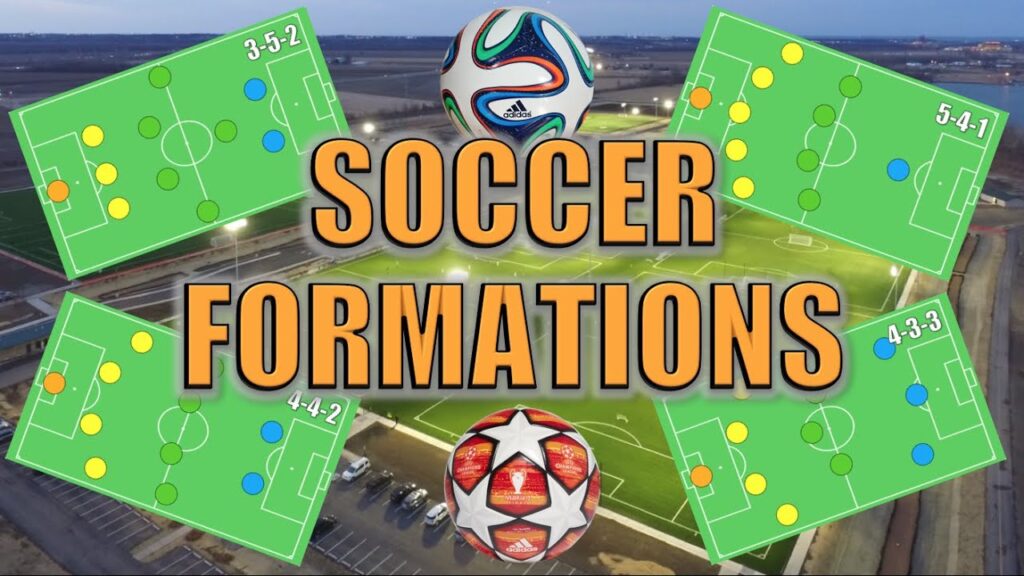
All Soccer Formations
The origin and evolution of soccer formations reflect the sport’s transformation from a chaotic early version to the organized and strategic game we see today. In the sport’s early days, there were no formal formations, and teams played with large numbers of players, emphasizing scoring goals.
As soccer began to formalize in the mid-19th century, figures like Charles W. Alcock and Ebenezer Cobb Morley advocated for more structured play, introducing basic formations like 1-2-7 and 2-3-5, which indicated the number of players in each line.
Significant developments included the “Hungarian Revolution” in the 1950s and the emergence of “Total Football” in the 1970s, which influenced modern formations.
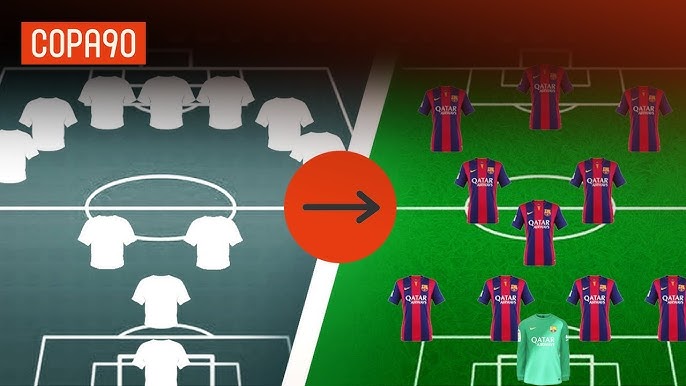
What Are Soccer Formations
Soccer formations are tactical arrangements of players on the field that dictate how a team organizes itself during a match. These formations are typically represented in a numerical format like 4-4-2, 4-3-3, or 3-5-2, where the numbers indicate the number of players in each section of the field: defenders, midfielders, and forwards.
Understanding soccer formations and their importance is crucial for both coaches and players, as they play a fundamental role in shaping a team’s strategy and style of play.
In essence, soccer formations are the blueprints for how a team approaches a game. They provide structure, strategy, and organization to players on the field. Coaches select formations that align with their team’s strengths and the context of a particular match, and players must understand their roles and positions within the formation to execute it successfully.
The dynamic nature of soccer formations adds depth and complexity to the sport, making it more engaging and strategic for both players and fans.
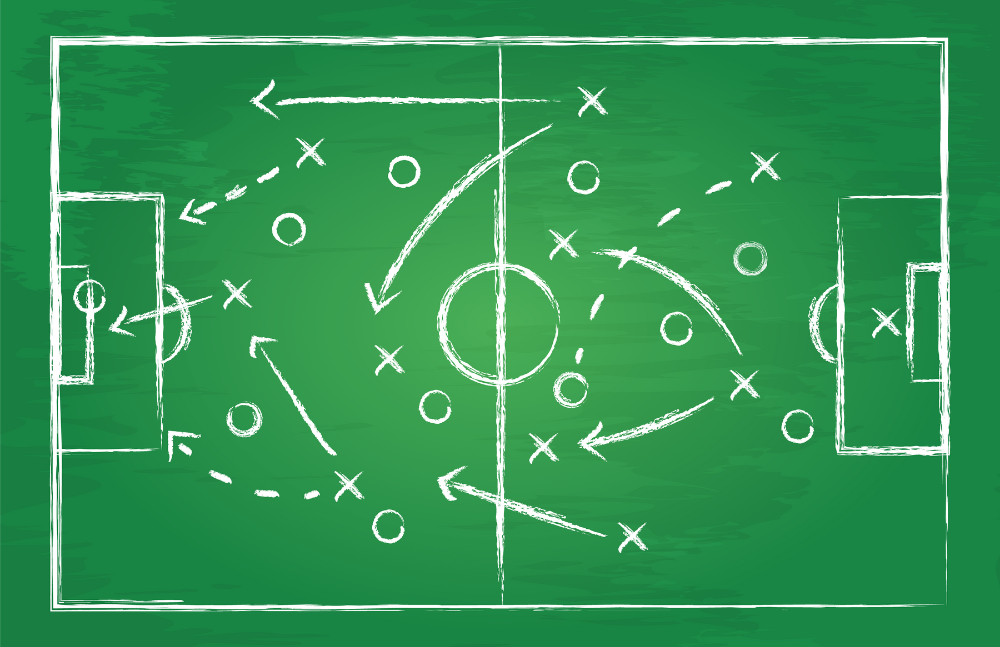
10 Most Common Soccer Formations
Soccer formations vary in terms of their numerical configurations and tactical approaches. Each formation has its own set of benefits and is often chosen based on a team’s strengths, style of play, and the specific context of a match. Here is a list of the most common soccer formations:
- 4-4-2
- 4-3-3
- 4-2-3-1
- 3-5-2
- 4-1-4-1
- 3-4-3
- 4-5-1
- 4-3-2-1
- 5-4-1
- 4-2-2-2
The choice of a formation depends on a team’s tactical objectives, the strengths of the players, and the specific context of the match. Each formation offers unique benefits, and successful teams often adapt their formations to exploit the weaknesses of their opponents while maximizing their own strengths.
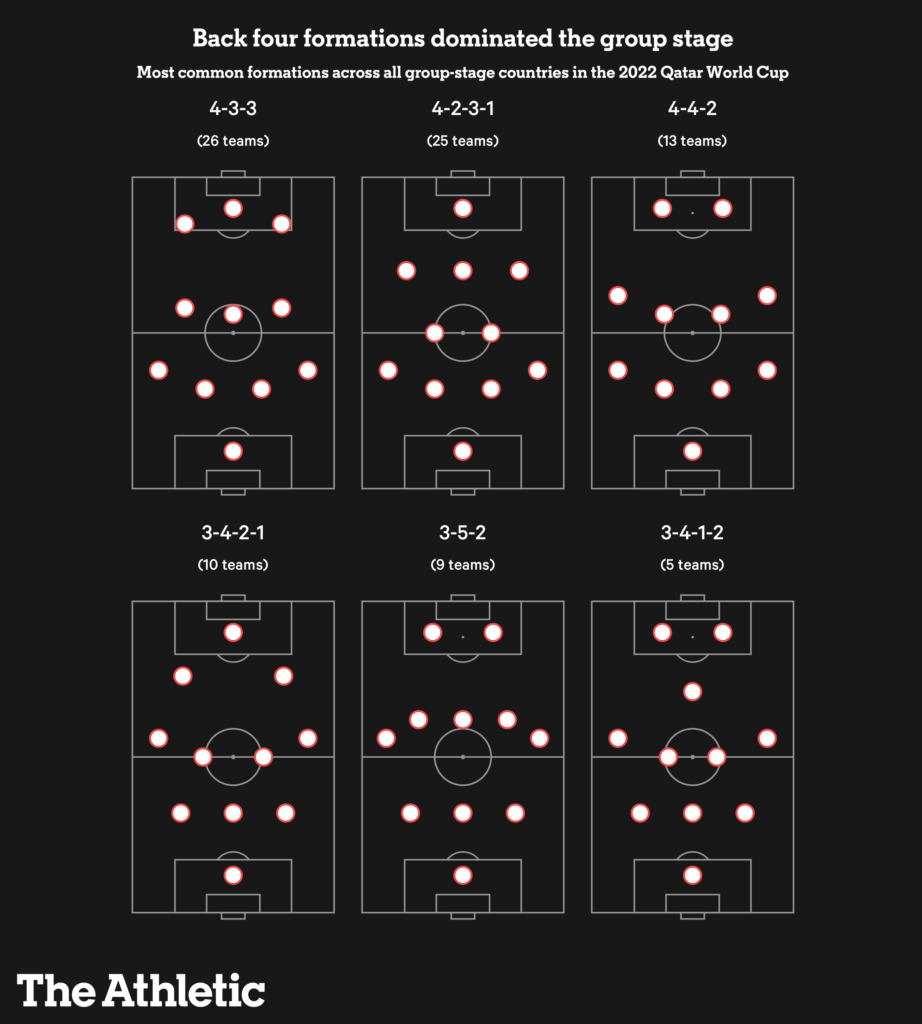
(4-4-2) All Soccer Formations Explained
The 4-4-2 formation is renowned for its defensive solidity, featuring four defenders who create a robust foundation at the back. This setup acts as a defensive bulwark, making it challenging for opponents to breach the defensive lines.
Furthermore, it offers a well-balanced midfield structure with two banks of four players. This equilibrium ensures both control and support, whether in defense or offense.
What makes the 4-4-2 especially effective in attack is the presence of two strikers upfront. This allows teams with two formidable forwards to form a potent attacking partnership, increasing the chances of scoring goals.
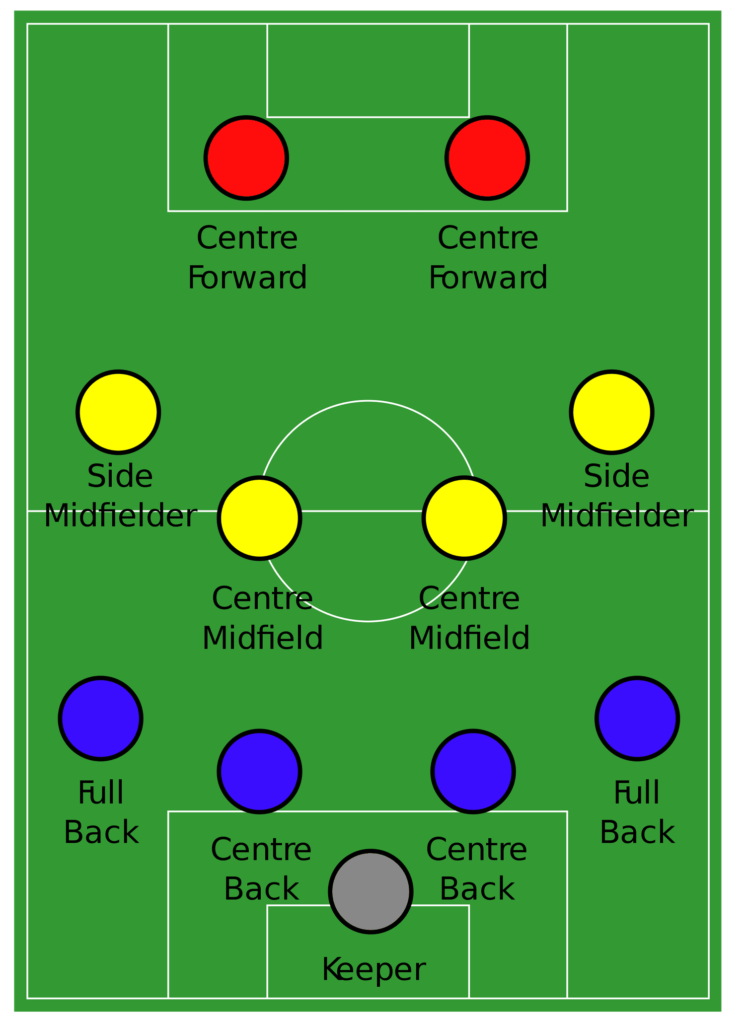
(4-3-3) All Soccer Formations Explained
The 4-3-3 soccer formation is distinguished by its emphasis on attacking play, incorporating three forwards and three midfielders. This configuration fosters an abundance of attacking options, encouraging teams to be proactive in their pursuit of goals.
The 4-3-3 formation is also renowned for its effectiveness in high pressing, making it a formidable choice for teams seeking to regain possession quickly. The presence of three forwards puts pressure on the opponent’s defense, while the midfielders can swarm the opposition.
Additionally, the wingers in the front three are vital components for exploiting wide spaces on the field and delivering crosses into the box, adding width and variety to the team’s attacking strategy.
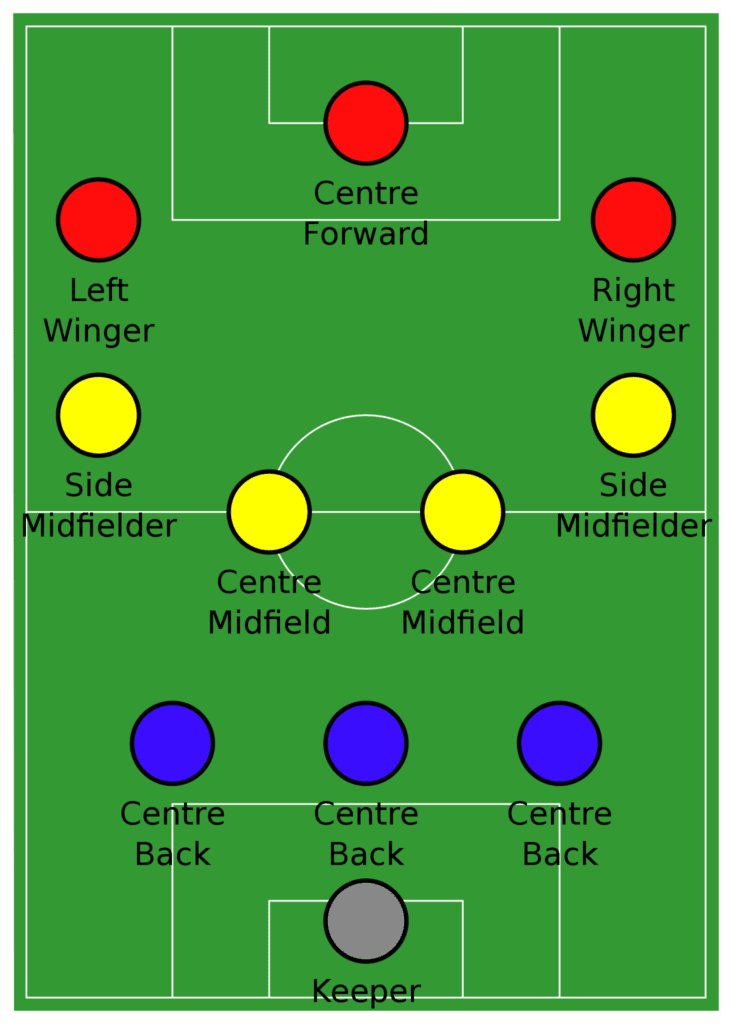
(4-2-3-1) All Soccer Formations Explained
The 4-2-3-1 soccer formation boasts a solid defensive foundation with two defensive midfielders who act as a protective shield for the backline, enhancing the team’s ability to thwart opposing attacks and maintain stability in the defensive third.
In the midfield, the presence of a central attacking midfielder is a pivotal component, capable of orchestrating and creating scoring opportunities for the team. This formation also offers versatility in attack, as it features a single striker supported by attacking midfielders who provide adaptability in offensive play.
With this structure, teams can seamlessly transition from a solid defensive posture to a dynamic attacking force, making the 4-2-3-1 a well-rounded formation suitable for a wide range of tactical approaches.
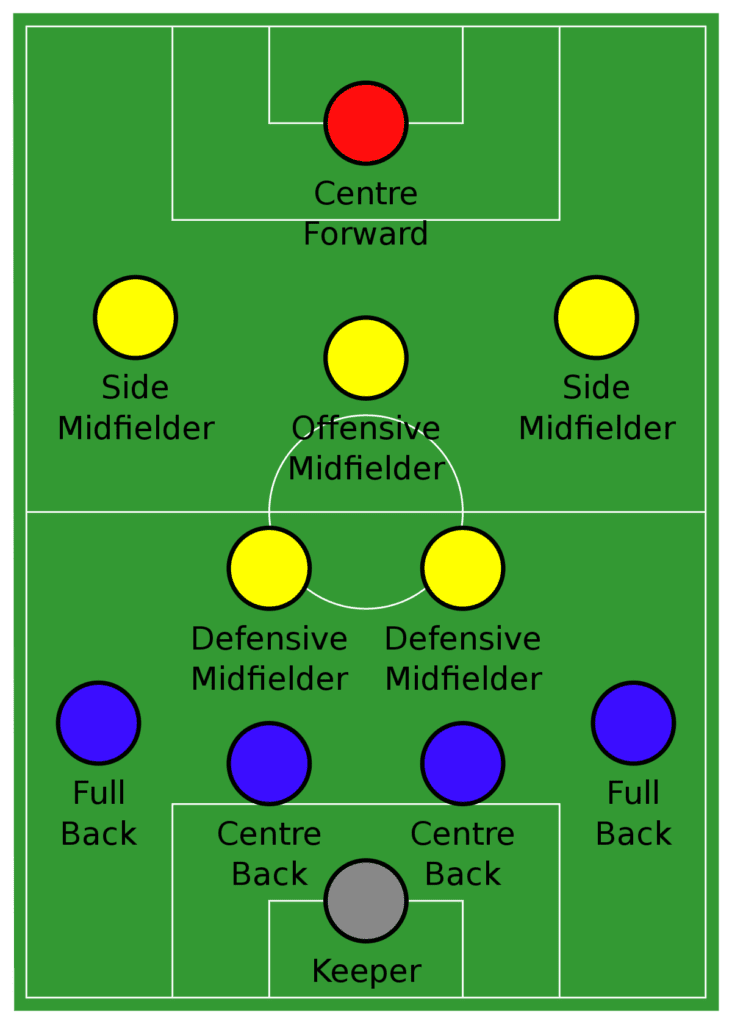
(3-5-2) All Soccer Formations Explained
The 3-5-2 soccer formation is a strategic choice that combines a formidable midfield presence with a sturdy defense. With five midfielders in play, this formation ensures not only control of the center of the pitch but also a numerical advantage over the opponent in that area.
Three central defenders contribute to defensive compactness, forming a solid defensive base that can be tough to breach. What makes the 3-5-2 formation particularly dynamic is the presence of two strikers who can work in tandem.
This offers a versatile attack, with the striking pair capable of providing support to each other and creating a formidable attacking force. In essence, the 3-5-2 formation combines midfield dominance, defensive resilience, and attacking adaptability, making it a well-rounded choice for teams seeking balance in their playstyle.
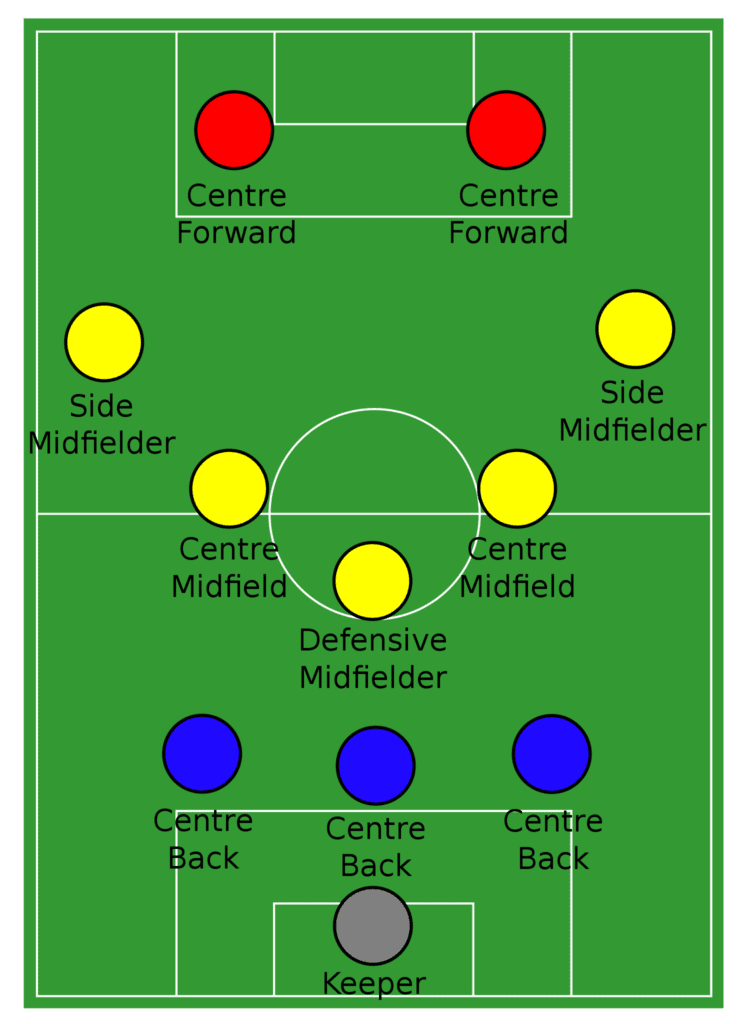
(4-1-4-1) All Soccer Formations Explained
The 4-1-4-1 soccer formation is recognized for its robust defensive structure, underpinned by the presence of a solitary defensive midfielder who acts as a crucial shield for the backline. This formation excels in controlling and maintaining possession, thanks to the midfield diamond configuration.
It ensures effective ball circulation and control, allowing teams to dictate the tempo of the game. Furthermore, the 4-1-4-1 is well-suited for quick and efficient counterattacks. Its swift transitions from defense to attack make it an ideal choice for teams aiming to exploit opportunities on the break, capitalizing on turnovers and taking opponents by surprise.
In sum, the 4-1-4-1 formation offers a blend of defensive solidity, possession control, and a dynamic approach to counterattacking, making it a tactical favorite for teams seeking a balanced strategy.
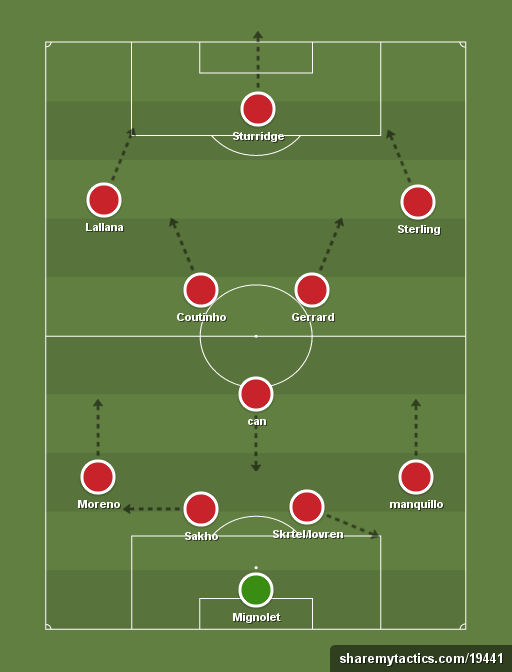
(3-4-3) All Soccer Formations Explained
The 3-4-3 soccer formation is celebrated for its inherent attacking prowess, featuring a front line of three forwards supported by a midfield quartet. This combination creates a potent offensive force on the field, providing the team with a multitude of scoring options.
A notable attribute of this formation is its emphasis on wide play, facilitated by the wingbacks. These players have the freedom to overlap and contribute to both offensive and defensive phases, widening the pitch and delivering crosses.
Moreover, the 3-4-3 formation thrives on fluidity, allowing for versatile attacking movements and combinations. This tactical flexibility enables teams to adapt to changing situations, making it a favorable choice for those looking to maintain an attacking edge while retaining tactical adaptability.
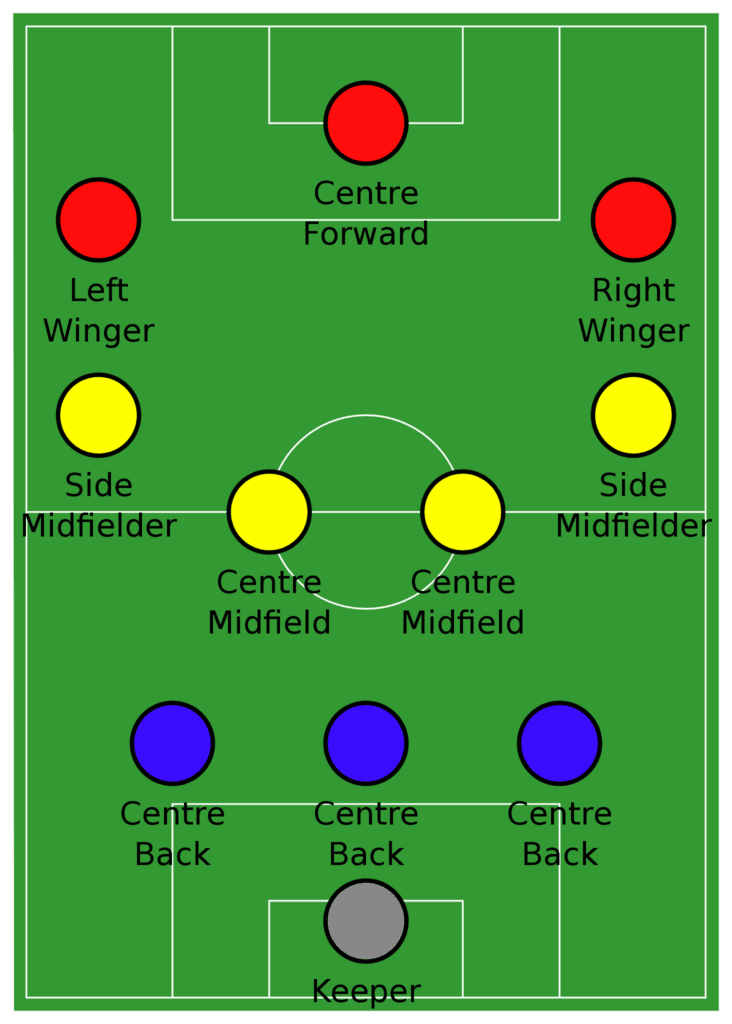
(4-5-1) All Soccer Formations Explained
The 4-5-1 soccer formation is primarily known for its defensive security, with a compact five-man midfield providing robust coverage in the middle of the pitch. This setup makes it challenging for opponents to breach the defensive lines, offering a solid foundation for the team.
Moreover, the formation excels in possession control, with midfield dominance allowing for effective ball circulation and dictation of the game’s tempo. This control of the midfield is essential for teams seeking to maintain possession and manage the rhythm of the match. The 4-5-1 also lends itself to effective counterattacking strategies, with quick transitions facilitated by the support of the midfielders.
When turnovers occur, the team can swiftly shift from defense to attack, taking full advantage of the midfield presence to initiate fast, incisive counterattacks. In summary, the 4-5-1 formation combines defensive solidity, possession control, and counterattacking efficiency, making it a versatile choice for teams aiming to maintain control of the game while capitalizing on swift transitions.
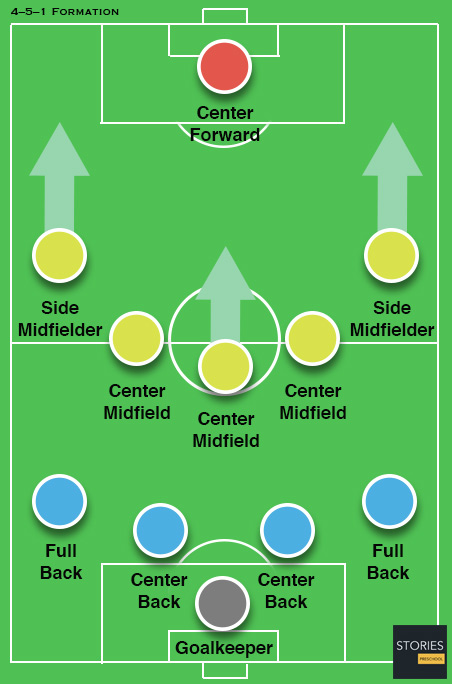
(4-3-2-1) All Soccer Formations Explained
The 4-3-2-1 formation, often referred to as the “Christmas Tree” due to its shape, places a heavy emphasis on central play. With two attacking midfielders occupying the central area, this formation creates a central overload, allowing the team to control and dictate the game from the middle of the pitch.
This strategic positioning is not only beneficial for offensive creativity but also provides a strong defensive base. The solid midfield foundation aids in winning the ball higher up the field, contributing to a proactive defensive approach. Additionally, the 4-3-2-1 formation is well-suited for pressing and regaining possession centrally, making it a favored choice for teams seeking to disrupt their opponents’ build-up play and maintain control in key areas of the pitch.
In summary, this formation combines central dominance, a solid defensive core, and effective pressing, making it a versatile choice for teams looking to exert influence both offensively and defensively from the center of the pitch.
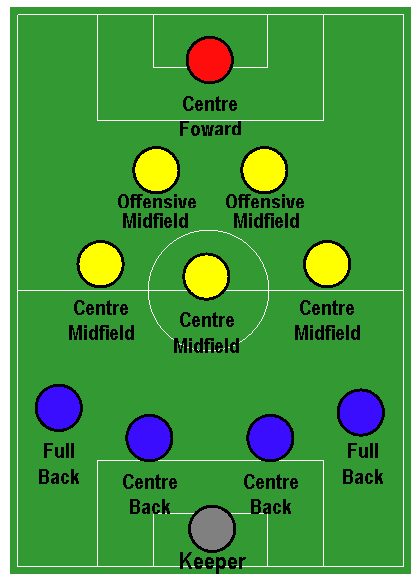
(5-4-1) All Soccer Formations Explained
The 5-4-1 soccer formation is characterized by its strong focus on defense and is an ideal choice for teams looking to protect a lead or maintain a highly defensive posture. With five defenders in the lineup, this formation establishes a solid and compact defensive structure that can be challenging for opponents to breach.
The midfield, featuring four players, is instrumental in both controlling the game and executing efficient counterattacks. These midfielders contribute to a balanced blend of defensive cover and the ability to transition swiftly from defense to offense.
In essence, the 5-4-1 formation excels in offering defensive strength, a resilient midfield presence, and an overall compact defense, making it a strategic choice for teams seeking to secure a lead or stymie the opponent’s attacking efforts.
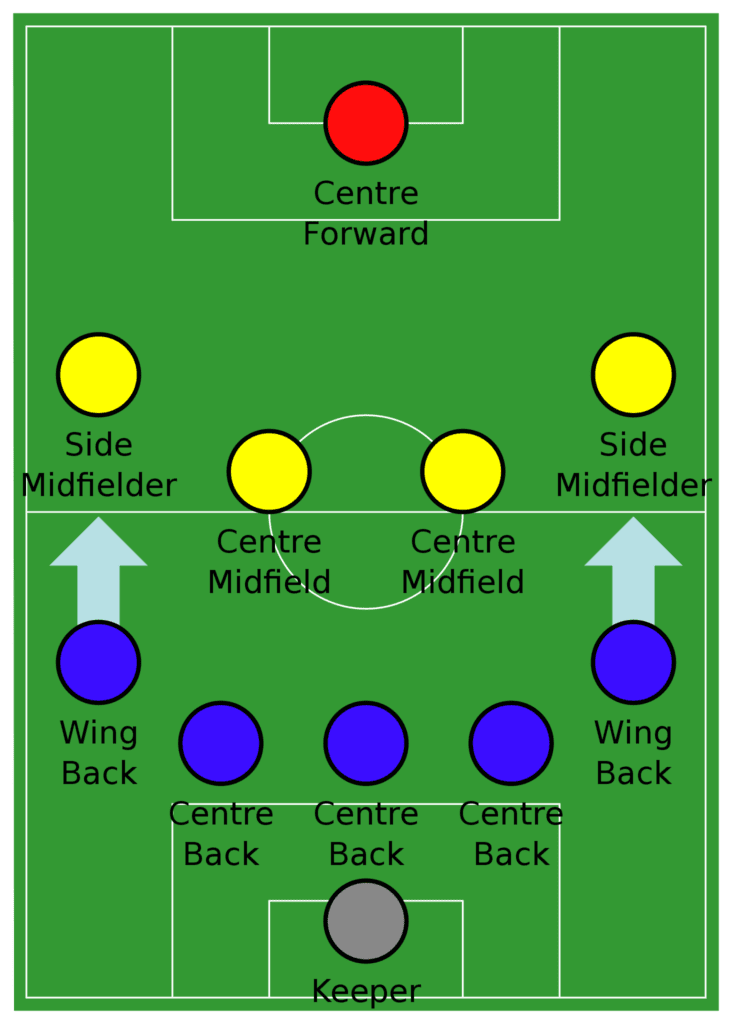
(4-2-2-2) All Soccer Formations Explained
The 4-2-2-2 soccer formation is notable for its dynamic attacking setup, featuring two pairs of forwards that create a formidable partnership up front. This dual-striker approach enhances the team’s attacking options, allowing for intricate combinations and increasing the chances of scoring goals.
In the midfield, the formation maintains a balanced structure with two holding midfielders positioned in the center. These players provide defensive stability and act as a link between the defense and attack. Additionally, the 4-2-2-2 encourages a comprehensive approach to the game by involving the full-backs in the attack. These players not only support the offense but also widen the play, contributing to a multifaceted offensive strategy.
In summary, the 4-2-2-2 formation combines a potent double striker partnership, a solid central midfield presence, and wide play provided by the full-backs, making it an attractive choice for teams aiming to maintain a versatile and goal-hungry attack.
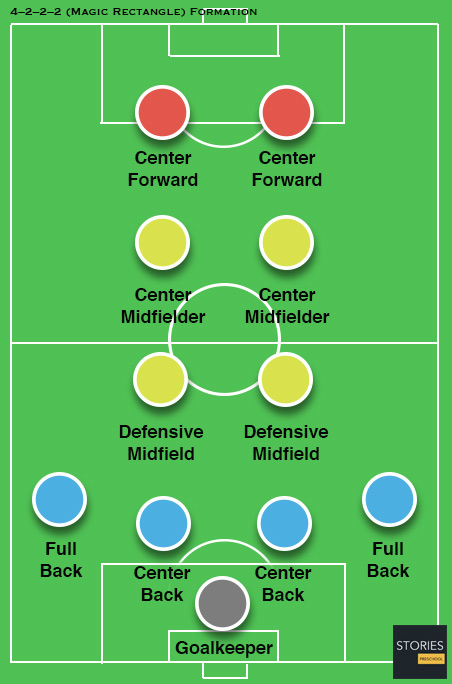
Soccer Formations Explained (VIDEO)
Whether you’re a soccer aficionado or just curious about the game, this video will provide a concise and captivating overview of soccer formations, helping you better appreciate the beautiful game. So, sit back, relax, and let’s dive into the world of soccer tactics, all without having to read a single word.
Each formation has its strengths, and successful teams choose the one that best aligns with their tactical objectives, player strengths, and the specific context of a match. Formations continue to evolve, reflecting the ever-changing nature of the beautiful game.
The Next Step
If you found this article helpful, you’ll absolutely love The Soccer Success Planner.
Are you tired of feeling like you’re not making progress in your soccer skills? Do you want to have a more organized and effective training routine? Do you struggle with setting and achieving your soccer goals?
If you answered yes to any of these questions, then the Soccer Success Planner is perfect for you. This planner will help you stay motivated, focused, and on track towards achieving your soccer goals. And it’s completely customizable to fit your unique needs!
Use the planner to set clear goals, track your progress, and stay accountable to yourself. With helpful prompts and exercises, you’ll be able to identify your strengths and weaknesses, plan your training sessions, and maximize your performance on the field.
Download your free copy now and start taking control of your soccer success today! You can download it here – Soccer Success Planner

Need Faster Improvements!?
Not getting better at soccer? Confused about how to train effectively? Maybe you’re worried that you won’t be properly prepared for your next big opportunity? Or you just want to standout and actually feel respected by your teammates, coaches, and friends?
Whatever struggles you’re going through, The Online Soccer Academy is the best solution to help you overcome obstacles and achieve goals. Thousands of satisfied players have already taken the next step and achieved incredible results in record time.
With expert coaching, structured player development systems, and easy-to-follow training routines, it’s guaranteed to elevate game.
Join today and start experiencing the transformation you’ve been waiting for!
Get more information here – Online Soccer Academy

About The Author
If you don’t know about me…
I used to be a soccer player who struggled with self-confidence. I felt slow, weak, and unmotivated. My coaches didn’t pay much attention to me, my friends laughed at my lack of skills. At one point, I even became so discouraged that I quit the sport altogether.
Enough was enough. I decided to take control of my own development and set out on a journey to become a better soccer player. This path led me on an incredible journey of self-improvement.
I went on to win league and goal-scoring titles, earn awards, lift trophies, and received a college scholarship. I’ve even earned international caps for my country.
I started sharing my knowledge with others and teaching them how to become the best soccer players they could be. My YouTube channel grew to over 500,000 subscribers.
In addition, I coached for several youth clubs in my local city, and even started my own soccer training company. I went on to coach the most prestigious men’s club in my city for several years.
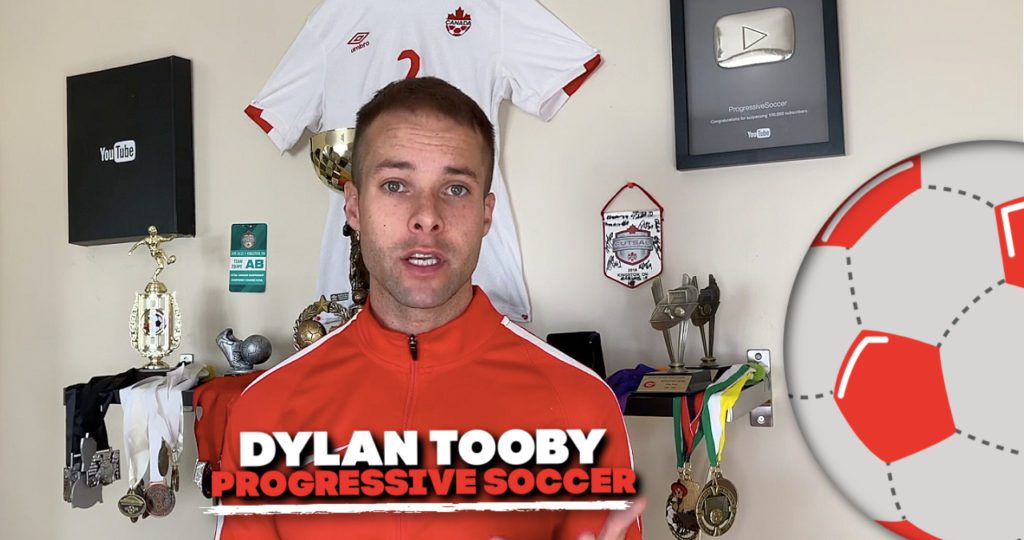
But enough about me, let’s focus on you.
If you’re looking to improve your skills, let’s take your soccer game to the next level. I want to help you make a noticeable change in style of play and overall performance on the field.
I’m passionate about helping players achieve their goals in soccer, and I’d love to be a part of your journey. I can help you reach your goals faster and achieve more in this sport, but I won’t force you. If you’re ready to take the next step, here’s what I suggest you do:
1) Download The Soccer Success Planner (FREE)
2) Apply To The Online Soccer Academy (Limited Spots)

Want more soccer training content?
Here are some related soccer articles you might enjoy:
How To Become A Professional Soccer Player
How To Become A Good Soccer Player
Wishing You Success In Soccer
Coach Dylan
Progressive Soccer
Thank you for reading this article:
All Soccer Formations (EXPLAINED EASILY)
